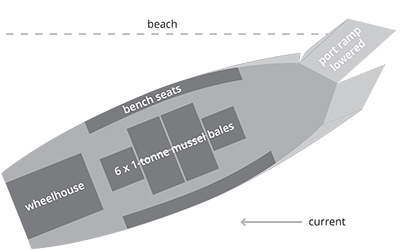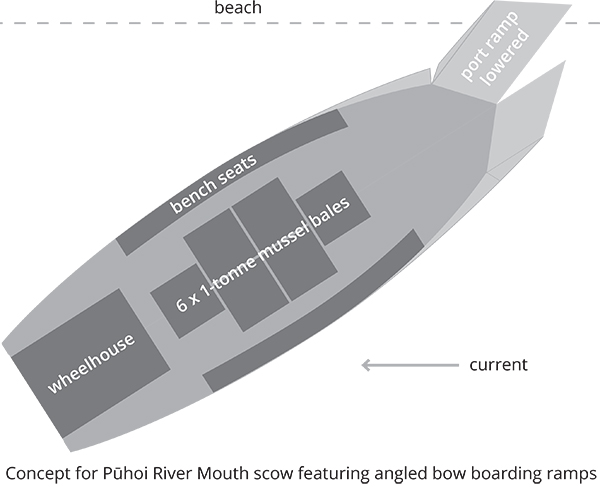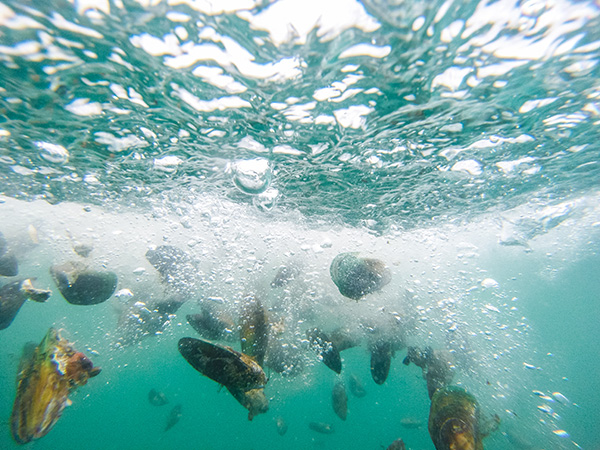Interim river-mouth scow and mussel restoration research


Doubly Serendipitous Scow Bow: Being able to beach without stranding, on a falling tide, is the defining criterium for any Pūhoi River Mouth ferry to operate without the cost and visual clutter of jetties and pontoons. The angled bow of the New Zealand scow provides the seed for a sublimely practicable solution to the need to beach sufficiently angled to attenuate the current’s leverage. Scow is also etymologically serendipitous, being an Anglicisation of the Dutch schouw—ferry boat. concept Mahurangi Magazine
At first blush, the roles would appear to be impossibly disparate.
One role is as a testbed for a Pūhoi River Mouth reaction ferry. The other is as Mahurangi Action’s all-purpose scow, for everything from mussel-reef restoration research to ferrying folk across the Mahurangi Harbour during the annual regatta weekend.
The research requirement materialised when the last Warkworth Town Hall Talk spawned what is shaping up to become a five-year, $1 million project. While oyster barges have been used to establish the existing five beds, and are available for future work, with six one-tonne bags of mussels aboard they are not ideal for working off Motuora in other-than-calm conditions. Also, the purpose of the project is research, to identify methods by which a meaningful percentage of the 400 square kilometres of green-lipped mussel reef that were extinguished by the mid-1960s can be affordably restored—at current costs, strategically restoring say 1% of the seafloor denuded would cost about $500 million. Having first call on a suitable craft from which to dive, to deploy and monitor the various trial establishment methods will make the work of the scientists involved considerably more productive.
A surprising number of the required attributes of craft to perform the respective roles coincide. The only, partial, exception is the need for the ferry to avoid the hard chine that barges typically feature, which could all too readily crush the foot of a by-standing wader or swimmer in the Pūhoi River Mouth. A double chine, whereby the bottom transitions to the side via a 45° flat section, is all that is required to make standing too close to the craft as it impacts the beach, considerably less hazardous. A bonus is that a double-chined craft will create a little less dragturbulent flow than a comparable hard-chined design, and hence be a little more economic to propel.

Help on its Way: About 10 million green-lipped mussels have been deposited in the Hauraki Gulf, including in four Mahurangi sites and one off Motuora. Mahurangi Action’s planned scow, in addition to getting the Mahurangi Coastal Trail in use, will be the research vessel in the quest to finding an affordable way to begin the at-scale restoration of the 400 square kilometres of mussel beds that once filtered the entire gulf every 48 hours. image Shaun Lee
Saluting the defining chevron bow of the New Zealand scow was not prerequisite. Serendipitously, however, it provides an elegantly apposite solution to the need to beach at a pronounced angle, rather than square on, when operating in the current of the Pūhoi River Mouth. In the absence of current, beaching bow-on provides the least vulnerability to stranding, due to the weight of passengers embarking, or a falling tide, or both. Beaching side on, aside from the potential for stranding, reduces the depth available for the propeller when needing to pull the ferry clear. Likewise, it is advantageous for the rudder to have sufficient depth to operate, when using purely river current to propel the ferry from shore to shore, that is, in reaction-ferry mode.
Meanwhile, thanks to the use of barges belonging to New Zealand’s preeminent oyster grower—locally-based Biomarine—the deposition of a further 20–30 tonnes of mussels will take place in and near the harbour in November. But the costs involved even with that generosity, are considerable, reiterating the criticality of the Mahurangi research project.
Criteria for interim river mouth ferry and mussel barge
Criteria for mussel barge
Principal criteria for mussel-reef restoration research barge:
- Carry up to 6 x 1-tonne bales of mussels on deck—suggesting a craft of about 3.6 x 10 metres on deck
- Allow contents of bales to be bottom-discharged (probably over the bow) with minimum of manual handling
- Permit scuba-equipped divers to readily enter and leave water
- Provide shelter and a toilet for divers and other researchers.
Criteria for cable ferry prototype
A lack information on cable ferries operating in tidal river-mouth environments suggests prototyping with a disposable or re-deployable vessel. The prototyping phase will also inform the project as to the energy requirements in addition to that derived from the tidal river current. A prototype cable ferry crossing must:
- Be capable of being propelled by reacting to tidal current and autonomously during slack water
- Be capable of being operated without shore infrastructure
- Draw upon best available knowledge to inform design and operation
- Be able to be provided at minimal cost and/or have a use beyond the prototyping phase and/or be useful in providing an interim, donation-only, service.
Principal criteria for cross harbour ferrying:
- Carry up to 30 people seated on deck
- Permit passengers to readily embark/disembark beach or jetty
- Displacement hull to reduce wake when travelling through anchorages and within 200 metres of shore, and within 50 metres of other craft—leaving limited opportunity to travel at planing speed during the 1.3-kilometre crossing
- Provide shelter for crew.
Criteria for Mahurangi Coastal Trail
This hierarchy of criteria groups begins with for the Mahurangi Coastal Trail itself, which must:
- Be culturally connected and environmentally sensitive
- Be reasonably adjacent to the coastline
- Be accessibility- and family-friendly
- Be available everyday
- Be traversable continuously during daylight hours (i.e. be all-tide)
- Be adaptable to sea-level rise
- Be economically sustainable.
High-level criteria for crossing
The Pūhoi River crossing must:
- Have a minimal landscape and visual impact
- Be an all-tide crossing
- Not impede navigation
- Be an affirming experience for coastal trail users.
Criteria for ferry crossing
Assuming crossing style is a ferry crossing, without ruling out the possibility, however unlikely, that a preferable alternative is identified, the ferry crossing must:
- Operate in all but heavy or extreme weather
- Not require dredging
Criteria for river-mouth ferry crossing
The previous criteria dictate a river-mouth ferry crossing, as this is the only point at which sand and mud banks don’t impede traverse. A river-mouth ferry crossing must:
- Have only low impact on geomorphology of vulnerable Wenderholm sandspit, including on the sand-binding plants, which are currently at risk from foot traffic (northern bank is geomorphically stable, being stone rather than sand)
- Present narrowest aspect to passing vessels (i.e. ferry-glide, rather than proceed at right angles to current)
- Dock without shore-crew assistance
Criteria for cable ferry
The preceding criteria dictate a cable ferry, as jet or propeller driven craft would tend to scour the Wenderholm sandspit, particularly in conjunction with stronger tidal flows. A cable ferry crossing must:
- Minimise cable interference to passing vessels, and vice versa
- Possess adequate directional control when underway
- Possess adequate directional control when paused partway across channel, such as to allow another vessel to pass ahead of the ferry
- Operate cleanly and quietly—for aesthetic and environmental imperatives
- Operate continuously (and if electric, not be delayed by charging requirements)
- Provide accessibility at least equal to that of the Mahurangi Coastal Trail north of the Pūhoi River
Criteria for operation of cable ferry
Preceding criteria requires the experience of using the coastal trail be affirming and family-friendly. Operation of a chain ferry must:
- Be low- or zero-carbon
- If human-propelled, not pose risk to operators, such as through power being reversed to power crank handles.
- Be capable of being operated by one person, in an emergency.
